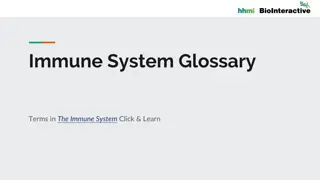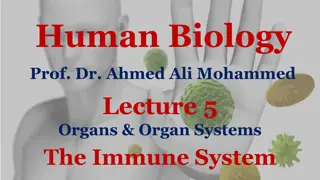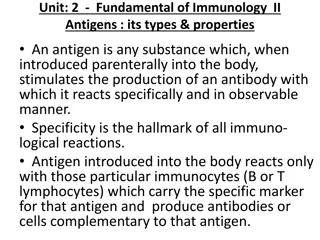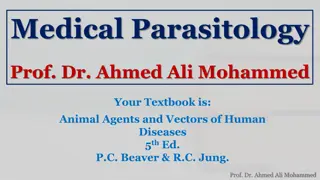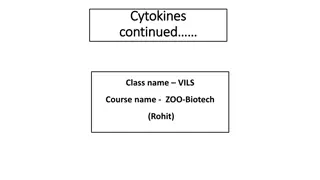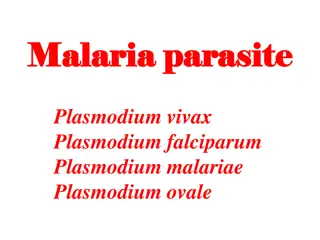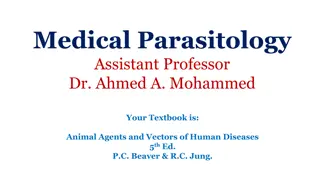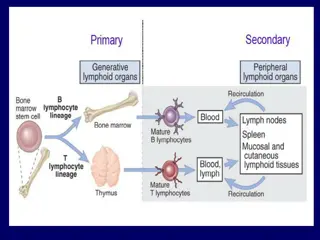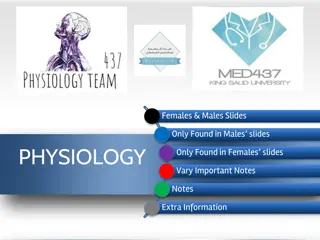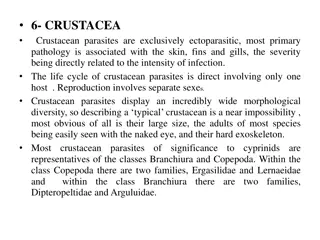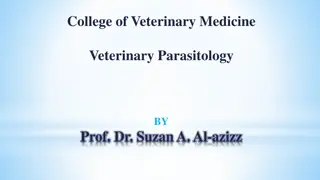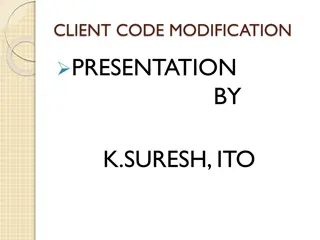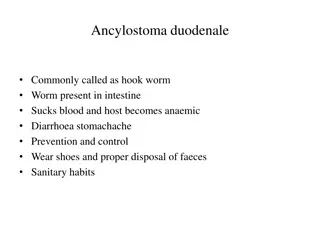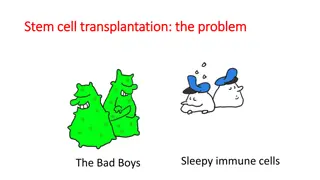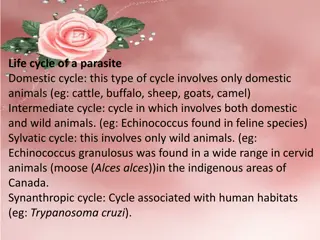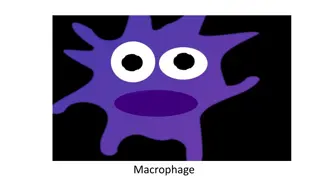Mechanisms of Immune Evasion by Parasites in Immunoparasitology
Understanding how parasites evade the immune system of their hosts is crucial in the field of immunoparasitology. Parasites have developed various strategies such as anatomical seclusion, antigenic variation, and intracellular living to avoid host immune responses. Examples include Plasmodium within red blood cells and Trypanosoma cruzi inside macrophages. This comprehensive study explores the intricate ways parasites counteract immune defenses to ensure their survival and transmission.
Download Presentation

Please find below an Image/Link to download the presentation.
The content on the website is provided AS IS for your information and personal use only. It may not be sold, licensed, or shared on other websites without obtaining consent from the author.If you encounter any issues during the download, it is possible that the publisher has removed the file from their server.
You are allowed to download the files provided on this website for personal or commercial use, subject to the condition that they are used lawfully. All files are the property of their respective owners.
The content on the website is provided AS IS for your information and personal use only. It may not be sold, licensed, or shared on other websites without obtaining consent from the author.
E N D
Presentation Transcript
IMMUNOPARASITOLOGY (Zoo 565) Mechanisms of immune evasion by parasites 1
Preface Parasite immune evasion is the process by which parasites counteract the immune system of the host. Parasites use diverse mechanisms to avoid and antagonize the immune response of their hosts. 2
Introduction Parasite Immune Evasion Evasion strategies. o Parasites need time in host - development, reproduce & ensure vector transmission. o Chronic infections normal. o Parasites evolved variety immune evasion strategies.
Objectives o Familiar with both vertebrate & invertebrate immune responses to a variety of parasites. o Familiar with range of strategies used by parasites to evade hosts immune mechanisms. o Able to give specific examples of parasites & their immune evasion strategies.
Contents Methods of immune evasion by parasites
Contents Protozoan immune evasion strategies. 1. Anatomical seclusion in vertebrate host. Parasites may live intracellular - avoid host immune response. o E.g. Plasmodium inside RBC s - when infected not recognised by TC & NK cells. Other stages Plasmodium inside liver cells. o Leishmania parasites & Trypanosoma cruzi inside macrophages.
Protozoan immune evasion strategies Trypanosoma cruzi Leishmania spp.
Protozoan immune evasion strategies 2. Anatomical seclusion in invertebrate host. o Plasmodium ookinetes in serosal membrane - beyond reach haemocytes. 3. Antigenic variation. o In Plasmodium, different stages of life cycle express different antigens. o Antigenic variation also in extracellular protozoan, Giardia lamblia.
Protozoan immune evasion strategies 3. Antigenic variation cont d. o African trypanosomes -1 surface glycoprotein that covers parasite = VSG. o Immunodominant for ab responses. o Tryps have gene cassettes of VSG s allowing regular switching to different VSG. o Host mounts immune response to current VSG but parasite already switching VSG to another type.
Protozoan immune evasion strategies. 3. Antigenic variation cont d. o Parasite expressing new VSG escapes ab detection, replicates & continue infection. o Allows parasite survival - months / years. o Up to 2000 genes involved.
Protozoan immune evasion strategies. 3. Antigenic variation cont d. Parasitaemia fluctuates. After each peak, trypanosome population antigenically different from that earlier / later peaks. After Ross, P. (1910), Proc. Royal Soc. London, B82, 411
Protozoan immune evasion strategies. 4. Shedding / replacement surface e.g. Entamoeba histolytica. 5. Immunosupression manipulation host immune response e.g. Plasmodium. 6. Anti-immune mechanisms - Leishmania - anti-oxidases to counter macrophage oxidative burst.
Helminth immune evasion strategies vertebrate host. 1-Large size Difficult to eliminate. Primary response inflammation. Often worms not eliminated.
Helminth immune evasion strategies vertebrate host. 2. Coating with host proteins. o Tegument cestodes & trematodes adsorb host components, e.g. RBC ags. o Immunological appearance of host tissue. o E.g. Schistosomes - host blood proteins, (blood group ags & MHC class I & II). o Worms seen as self .
Helminth immune evasion strategies vertebrate host. 3. Molecular mimicry. Parasite mimics host structure / function. E.g. schistosomes have E-selectin - adhesion / invasion. 4. Anatomical seclusion - 1 nematode larva does this -Trichinella spiralis inside mammalian muscle cells. 5. Shedding / replacement surface e.g. trematodes, hookworms.
Helminth immune evasion strategies vertebrate host. 6. Immunosupression manipulation of the immune response. High nematode burdens - apparently asymptomatic.Parasite may secrete anti-inflammatory agents suppress recruitment & activation effector leukocytes or block chemokine-receptor interactions .E.g. hookworm protein binds integrin CR3 & inhibits neutrophil extravasation.
Helminth immune evasion strategies vertebrate host. 7. Anti-immune mechanisms e.g. liver fluke larvae secretes enzyme that cleaves ab. 8. Migration e.g. Hookworms - move about gut avoiding local inflammatory reactions.
Helminth immune evasion strategies vertebrate host. 9. Production of parasite enzymes Filarial parasites secrete anti-oxidant enzymes (glutathione peroxidase & superoxide dismutase) resistance to ADCC & oxidative stress?
Helminth immune evasion strategies invert host. 1. Anatomical seclusion Acanthocephalaacanthors maintain host tissue layer around them. Acanthor only melanized if larva dies. 2. Molecular mimicry Schistosoma sporocysts produce surface molecules similar to haemolymph molecules of snail host. Parasite seen as self .
Helminth immune evasion strategies invertebrate host. 3. Immunosupression developing microfilariae Brugia pahangi & Dirofilaria immitis suppress mosquito immune response.
Final Activity Give reason Schistosoma can evade the immune system Schistosoma cause: - -antigen disguise. - antigen mimicry. -antigen shedding. -Cause inactivation of complement by protease activity. - Produce blocking antibodies. Host s RBCs
Summary I Protozoa evade vertebrate Protozoa evade invertebrate immunity by : immunity by: Anatomical seclusion. Anatomical seclusion. Antigenic variation. Surface shedding / replacement. Immunosupression Anti-immune mechanisms.
Summary II Helminth evade vertebrate immunity by : Size Anti-immune mechanisms. Using host protein. Migration. Molecular mimicry. Production enzymes Anatomical seclusion. Surface shedding / replacement. Immunosupression.
Summary III Helminth evade invertebrate immunity by : Anatomical seclusion. Molecular mimicry. Immunosupression.



